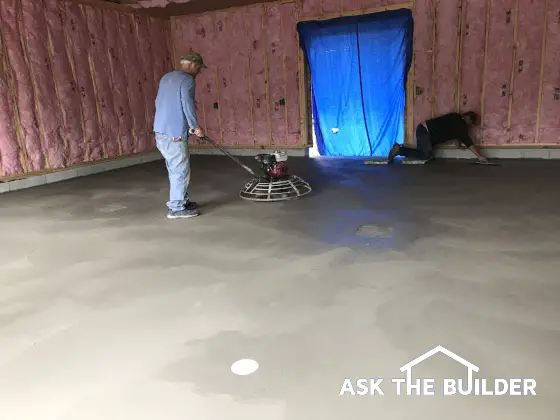Don’t Underestimate Concrete Installation and A Water Leak

You’re looking at a professional finishing concrete. It’s not as easy as it looks. (C) Copyright 2019 Tim Carter
Don't Underestimate Concrete Installation
QUESTION #1: I plan to install a concrete patio during my vacation. It’s going to measure 14 feet by 30 feet. I’ve watched lots of online videos and paid attention to cable-TV shows and now feel emboldened. What can go wrong and how much help do you think I’ll need. I’ve never done a job like this and feel it’s doable. What advice can you add to the mix? Ronnie S., Tyler, TX
Ronnie’s concrete quest reminds me of the can’t-fail spirit I relied on early in my career when I tried to do something new. It’s important to realize back then there were no online videos or cable-TV shows to instill a dangerous sense of bravado.
The first time I tried to do a large concrete job on my own, I was but 23-years-old and had never done anything like it before. I was pouring a set of steps alone and a short section of sidewalk at an older home I was rehabbing. How hard could this be?
It’s so much harder than you can ever imagine. The first thing that went wrong is I never thought how the concrete wouldn’t flow horizontally across the truck chute to get to the uppermost steps. The top steps were just about a foot below the top of the truck chute. About a half a cubic yard of concrete had to be hand shoveled from the chute and the truck driver was kind enough to help.
Another key point is that concrete installation is true science. Scientists devote their entire careers to the study of this man-made material. Most of the online videos I’ve seen about the concrete installation process gloss over extremely important details.
The mix you order from the concrete plant needs to match the extreme weather conditions you’ll experience outside your home. You often will see that 4,000 pounds per square inch (PSI) concrete should be used in climates that experience freezing weather. Note this is a MINIMUM standard. You can order stronger concrete and it might be a good idea to do so.
Water is both the friend and foe of concrete. Add too much at any point in the mixing or installation process and you can ruin the concrete. Allow too much water to evaporate from the concrete after you’re washing off your tools, and you can weaken the concrete. New concrete needs to retain water, it’s called curing, so the microcrystals in the concrete can continue to grow for months after the ready-mix truck leaves your home.
Concrete is very strong when squeezed, but it only has one-tenth that strength when subjected to tension. Tension is when concrete gets bent by hollow voids under the new concrete or from frost heaving in cold climates. The addition of reinforcing steel is a must if you want to ensure your new patio doesn’t develop wide ugly offset cracks.
Your new patio is going to shrink. Concrete tends to shrink 1/16th inch for every ten horizontal feet. This shrinkage pulls the concrete apart and can cause ugly random cracking. It’s best to put in your own control joints in the wet concrete. These pre-weakened joints must be a minimum of 1/4th the thickness of the slab. All too often contractors make them too shallow.
Lastly, don’t underestimate the enormous amount of work to get the concrete from the truck into the forms. You’ll need at least six or eight helpers, especially since none of you have ever done this type of work before. Pour just before the sun rises so you don’t die of heat stroke! Good luck!
A Water Leak
QUESTION #2: Tim, I’m building a new home and visited it during a driving rainstorm. There was water coming into the house. The siding has yet to be installed outdoors but a self-adhered water barrier is in place. Everything looks fine and there were no loose pieces of water barrier flapping in the wind. There’s a direct-vent fireplace exhaust hood on the wall above the area that was leaking. What could be wrong? Beverly W., Arlington, VA
I rarely bet but in this case, I’d put all my pocket money on a faulty installation of the fireplace vent that passes through the wall. My guess is that after an autopsy is performed on the installation one will discover that the installer failed to integrate the metal vent flashing with the self-adhered exterior water barrier.
All too often contractors and subcontractors rely on caulk to seal penetrations like this. Caulk, no matter what the builder tells you, is not a substitute for the proper overlapping of waterproof materials on the outside of your new home.
Think about how roof shingles and feathers on birds keep houses and birds dry. These materials overlap one another so the water flowing down is shed to the next layer. If you overlap things the wrong direction, water can get behind and cause nightmares.
In a perfect world, the fireplace installer would have been working hand-in-hand with the contractor at the same time the exterior water barrier was being installed. A second option would have the exterior vent at the job site early in the job. The water barrier installer could have attached it to the wall as he put up the barrier. The fireplace vent pipe could have been installed backward going towards the fireplace. You need to apply critical thinking skills to challenges like this.
Column 1307